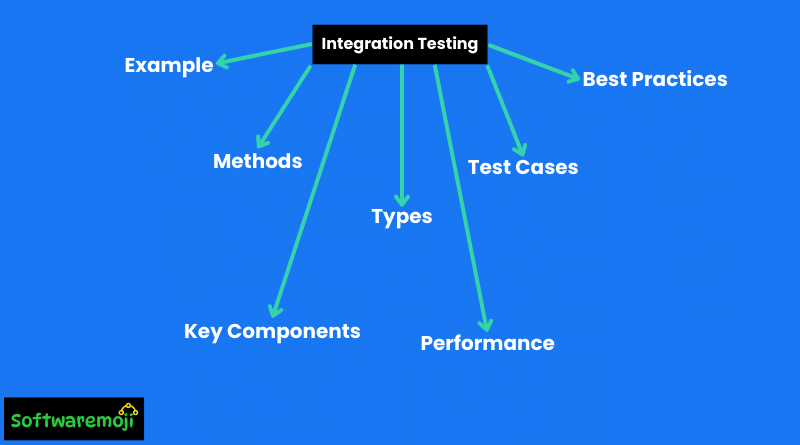
📌Integration Testing:
- Integration Testing ensures that different software modules work together seamlessly, boosting overall application reliability.
- There are two major types of Integration Testing: Incremental Integration and Big Bang Integration, each suited for different project needs.
- Top Integration Testing methods include Top-Down, Bottom-Up, Sandwich (Hybrid), and Big Bang approaches for comprehensive validation.
- Following Integration Testing best practices like clear interface definitions and early defect detection leads to faster product delivery.
- Automated Integration Testing with tools like JUnit, TestNG, and Selenium improves testing efficiency and minimizes human errors.
- Mocking and Stubbing techniques help simulate missing components during early stages of Integration Testing.
Integration Testing: Types, Methods, and Best Practices:
📌What is Integration Testing?
Integration Testing is a software testing technique where multiple modules of an application are combined and tested as a unit to identify defects in their interaction. It ensures that different modules developed by separate programmers function correctly when integrated. This testing primarily focuses on data communication and the correctness of interface links.
It is also known as ‘I & T’ (Integration and Testing), ‘String Testing,’ and ‘Thread Testing.’
📌Why is Integration Testing Important?
Even if individual software modules pass unit testing, issues can arise due to:
- Different developers having varied coding logic.
- Changing requirements during development that may not be unit tested.
- Interface issues with databases, external hardware, and APIs.
- Poor exception handling.
📌Example of Integration Test Cases:
Consider an email application with three modules:
- Login Page
- Mailbox
- Delete Emails
📌Test Cases for Integration Testing:
| Test Case ID | Objective | Description | Expected Result |
|---|---|---|---|
| 1 | Verify interface link between Login and Mailbox | Enter login credentials and click “Login” | User is directed to the mailbox |
| 2 | Verify interface link between Mailbox and Delete Emails | Select an email and click “Delete” | The email moves to the Trash folder |
📌Types of Integration Testing Approaches:
📌1. Big Bang Approach:
- All modules are integrated simultaneously and tested as a unit.
- Advantages: Suitable for small applications.
- Disadvantages: Difficult to locate defects; testing happens late in the cycle.
📌2. Incremental Approach:
Testing is conducted in stages by integrating logically related modules. This approach is further divided into:
📌a. Bottom-Up Approach:
- Testing begins with lower-level modules and moves up.
- Uses drivers as dummy programs to simulate higher modules.
- Advantages: Easy fault detection, no need to wait for full module development.
- Disadvantages: High-level modules are tested late.
📌b. Top-Down Approach:
- Testing starts from the top-level modules and moves downward.
- Uses stubs as dummy programs to simulate lower modules.
- Advantages: Critical modules tested first, major design issues identified early.
- Disadvantages: Many stubs are required, lower-level testing may be inadequate.
📌c. Sandwich Testing (Hybrid Approach):
- A combination of Top-Down and Bottom-Up testing.
- Both stubs and drivers are used for testing.
- Best suited for large, complex applications.
📌Key Components: Stubs & Drivers:
- Stubs: Used in top-down testing, act as placeholders for lower modules.
- Drivers: Used in bottom-up testing, simulate higher-level modules.
📌How to Perform Integration Testing?
📌Step-by-Step Process:
- Prepare an Integration Test Plan
- Design Test Scenarios, Cases, and Scripts
- Execute Test Cases and Report Defects
- Track and Re-test Defects
- Repeat until all modules function correctly
📌Integration Test Plan Overview:
Includes:
- Testing methodologies
- Scope of testing
- Roles and responsibilities
- Required test environment
- Risk mitigation strategies
📌Entry & Exit Criteria for Integration Testing:
Entry Criteria:
✔ Unit-tested modules
✔ Bug fixes for critical issues
✔ Integration test cases signed off
✔ Test environment setup
Exit Criteria:
✔ Successful testing of integrated modules
✔ Test case execution documented
✔ All high-priority defects resolved
✔ Technical documentation completed
📌Best Practices for Integration Testing:
✅ Choose an appropriate integration strategy before testing.
✅ Prioritize critical modules for testing.
✅ Test all interfaces, APIs, databases, and external connections in detail.
✅ Prepare mock test data in advance.
✅ Focus on exception handling and edge cases.
Related Post: Unit Testing:-
